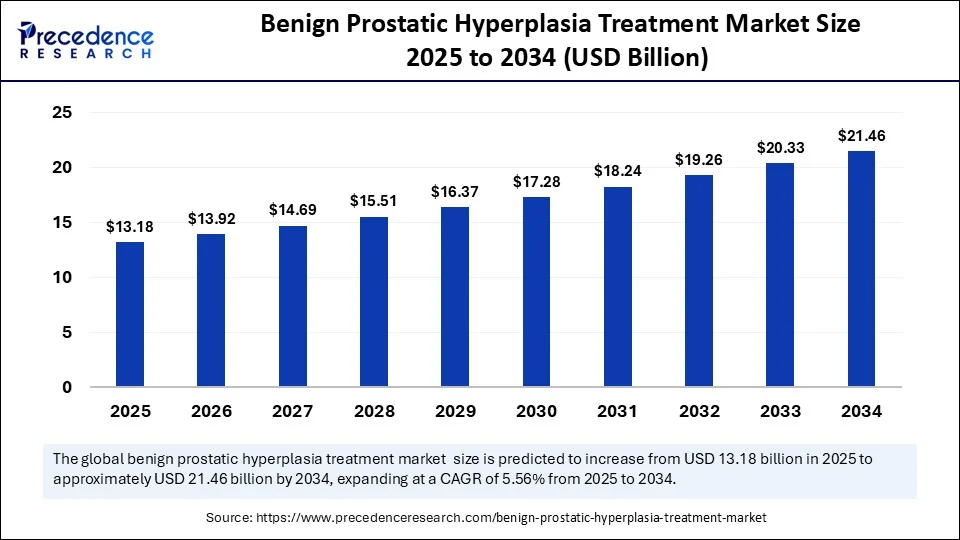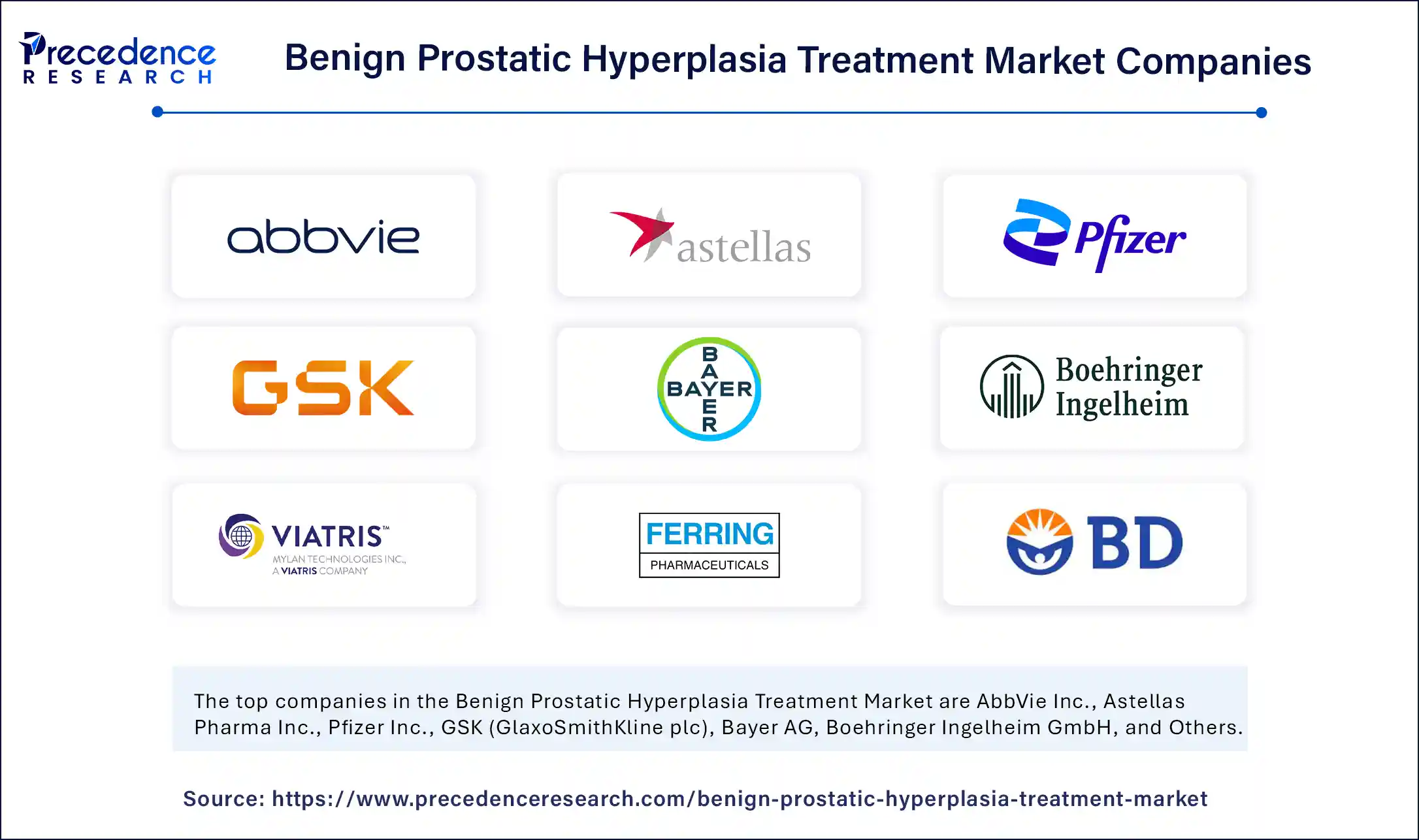
Benign Prostatic Hyperplasia (BPH) Treatment Market Key Points
-
The global benign prostatic hyperplasia treatment market was valued at USD 12.49 billion in 2024.
-
It is expected to reach approximately USD 21.46 billion by 2034, growing at a CAGR of 5.56% from 2025 to 2034.
-
North America led the market in 2024, holding the largest share of 35%.
-
The Asia Pacific region is projected to witness the fastest growth during the forecast period.
-
Based on treatment type, alpha-blockers accounted for the largest share of 28% in 2024.
-
The minimally invasive procedures segment is expected to grow significantly throughout the forecast years.
-
By end user, the hospitals segment dominated the market with a 65% share in 2024.
-
The ambulatory surgical centers segment is anticipated to experience strong growth during the forecast period.
-
In terms of patient age group, individuals above 60 years accounted for the largest share of 55% in 2024.
-
The 58.50-year-old age group is expected to grow notably over the forecast period.
-
Regarding distribution channels, the hospital pharmacy segment captured a substantial 60% share in 2024.
-
The online pharmacy segment is projected to expand considerably in the coming years.
Benign Prostatic Hyperplasia Treatment Market Growth Factors
Several structural and demographic trends are accelerating the growth of the BPH treatment market. Firstly, the aging population worldwide is contributing to a higher incidence of BPH, as the condition primarily affects older men. Secondly, technological advancements in minimally invasive surgical techniques are attracting both patients and healthcare providers due to their efficiency and lower complication rates.
Treatments such as Rezūm water vapor therapy, UroLift implants, and laser-based enucleation have gained widespread acceptance. Moreover, pharmaceutical innovation remains a cornerstone, with new drug formulations that combine alpha-blockers and 5-alpha-reductase inhibitors offering more comprehensive symptom management. Increased awareness and routine screening through PSA testing and digital rectal exams have led to earlier detection, thereby expanding the treatable patient pool.
Role of AI in the Benign Prostatic Hyperplasia Treatment Market
Artificial intelligence is playing a pivotal role in enhancing both diagnostic accuracy and treatment outcomes in the BPH treatment market. AI-powered imaging tools now enable more precise assessments of prostate size and obstruction levels using MRI and ultrasound, helping clinicians personalize treatment strategies. AI-based decision-support tools analyze patient data, including urinary flow rates, symptom scores, and PSA levels, to predict the likelihood of treatment failure and identify candidates for early intervention.
In operating rooms, AI-driven guidance systems assist in positioning implants or targeting laser ablation areas with high precision, reducing procedure times and improving safety. On the research side, AI accelerates drug development by modeling prostate tissue responses to new molecules, thereby optimizing the pipeline for next-generation BPH therapies.
Get this report to explore global market size, share, CAGR, and trends, featuring detailed segmental analysis and an insightful competitive landscape overview @ https://www.precedenceresearch.com/sample/6337
Market Drivers
The BPH treatment market is being propelled by strong drivers such as the growing prevalence of the condition, patient preference for minimally invasive solutions, and favorable reimbursement policies in key healthcare systems. The demand for treatments that offer quick recovery and fewer side effects has led to increased adoption of outpatient procedures.
Governments and private payers are aligning reimbursement strategies with cost-effective interventions that reduce hospital stays and long-term complications. At the same time, rising quality-of-life expectations among aging men—particularly in developed markets—are pushing primary care physicians to refer more patients to urologists for early management. The surge in elective urology visits and patient education programs has further strengthened market demand.
Opportunities
The market offers a wide array of opportunities for innovation and expansion. There is growing potential for the development of advanced, single-use devices tailored for ambulatory surgical centers and outpatient clinics. Additionally, digital therapeutics—such as smartphone applications that guide pelvic floor exercises, track symptoms, and offer teleconsultations—are opening up new revenue streams and enhancing patient engagement.
Pharmaceutical companies have the opportunity to develop more targeted, side-effect-free therapies, such as selective androgen receptor modulators or localized injections. Moreover, emerging economies present an untapped market for affordable, easy-to-administer solutions as awareness increases and public health infrastructure improves. Companies that can localize production and regulatory approvals for minimally invasive BPH treatments in regions like Asia, Latin America, and the Middle East will likely gain a competitive edge.
Challenges
Despite a strong outlook, several challenges need to be addressed. Generic alpha-blockers, which are widely used and inexpensive, continue to dominate the market, creating pricing pressure for newer pharmaceutical options. In the device segment, adoption of novel procedures may be limited by physician training gaps and regulatory hurdles in some countries. Moreover, reimbursement delays or uncertainties can hinder the penetration of advanced technologies in emerging markets.
Data privacy and compliance issues also pose a barrier to the widespread deployment of AI-based diagnostic and monitoring tools. Additionally, the complexity of managing overlapping conditions—such as prostate cancer or overactive bladder—may delay or complicate treatment decisions for BPH, reducing the speed at which patients access definitive therapy.
Regional Outlook
North America currently leads the BPH treatment market due to its sophisticated healthcare infrastructure, early adoption of innovative therapies, and supportive insurance systems. The U.S. alone is expected to contribute significantly to global revenues, especially as outpatient clinics and ambulatory surgical centers continue to grow.
Europe remains a stronghold for medical device innovation, with countries like Germany and the UK leading in the adoption of laser treatments and prostatic implants.
Asia-Pacific is witnessing the fastest growth, fueled by a rapidly aging population, rising healthcare spending, and a growing number of private urology clinics. Countries like Japan, China, and India are seeing increasing procedure volumes.
In Latin America and the Middle East & Africa, adoption remains relatively low but is on the rise as awareness spreads and governments invest in urological care.
Benign Prostatic Hyperplasia Treatment Market Scope
| Report Coverage | Details |
| Market Size by 2034 | USD 21.46 Billion |
| Market Size in 2025 | USD 13.18 Billion |
| Market Size in 2024 | USD 12.49 Billion |
| Market Growth Rate from 2025 to 2034 | CAGR of 5.56% |
| Dominating Region | North America |
| Fastest Growing Region | Asia Pacific |
| Base Year | 2024 |
| Forecast Period | 2025 to 2034 |
| Segments Covered | Treatment Type, End Use, Patient Age Group, Distribution Channel, and Region |
| Regions Covered | North America, Europe, Asia-Pacific, Latin America, and Middle East & Africa |
Benign Prostatic Hyperplasia Treatment Market Segmental Insights
-
By Treatment Type: Medications currently dominate the market, with alpha-blockers accounting for approximately 28% of total market share in 2024. However, the fastest-growing segment is minimally invasive surgical procedures, which include innovative technologies such as UroLift, Rezūm, and laser therapies that offer effective, same-day treatment with minimal recovery time.
-
By End User: Hospitals account for around 65% of the market share, primarily due to their comprehensive diagnostic and surgical capabilities. However, ambulatory surgical centers (ASCs) are experiencing rapid growth as they offer cost-effective, outpatient solutions that align well with evolving reimbursement models and patient preferences.
-
By Patient Age Group: Men over 60 years constitute the largest patient segment, accounting for nearly 55% of cases, due to the age-related prevalence of BPH. However, diagnoses in the 50–60 age group are increasing as screening programs and health awareness initiatives improve early detection.
-
By Distribution Channel: Hospital pharmacies dominate the distribution landscape, fulfilling over 60% of drug and device prescriptions. Meanwhile, online and specialty pharmacies are rapidly gaining traction, particularly as telehealth services enable remote consultations and follow-ups, making digital platforms a convenient option for medication refills.
Benign Prostatic Hyperplasia Treatment Market Companies

- AbbVie Inc.
- Astellas Pharma Inc.
- Pfizer Inc.
- GSK (GlaxoSmithKline plc)
- Bayer AG
- Boehringer Ingelheim GmbH
- Mylan N.V. (Viatris)
- Ferring Pharmaceuticals
- C.R. Bard, Inc. (BD)
- Olympus Corporation
- Teleflex Incorporated
- Boston Scientific Corporation
- Santarus, Inc. (Bausch Health Companies)
- Medi-Tech International Inc.
- UroGen Pharma Ltd.
- Sonacare Medical LLC
- Nobel Biocare Services AG
- Stryker Corporation
- Richard Wolf GmbH
- Johnson & Johnson (Ethicon)
Read Also: Diagnostic Dermatology Equipment Market
You can place an order or ask any questions, please feel free to contact at sales@precedenceresearch.com |+1 804 441 9344
- Arteriovenous Implants Market Enhance dialysis outcomes with advanced grafts, endovascular access, and AI-assisted precision - September 16, 2025
- Smart Retinal Implants Market Restore vision with wireless bioelectronic prosthetics and AI-powered retinal technologies - September 16, 2025
- Myopia Treatment Devices Market Size to Reach USD 38.51 Billion by 2034, Growing at a CAGR of 7.86% - September 1, 2025
